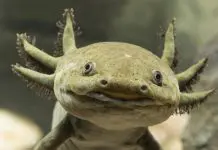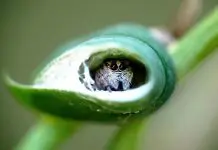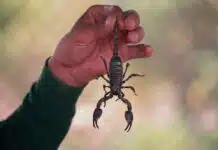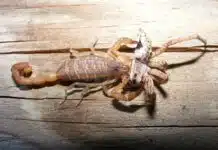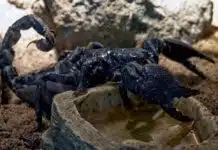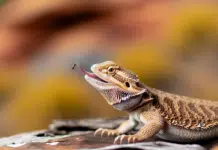Have you ever wondered how rattlesnake babies survive their birth? Do they get nursed by their parents? Lets find out.
Rattlesnakes do not nurse their young. They cant nurse their newborn babies as they don’t have mammary glands like mammals.
The fact might seem shocking to a lot of people as we are quite familiar with mothers breastfeeding their newborn babies. However, the trait is only found among the mammals. In fact, this character-defining trait is the primary identifiers of this class.
So, if the rattlesnakes don’t nurse their babies, how do they survive?
We know there are a lot of questions boggling on your mind regarding the rattlesnakes and how do they treat their newborns.
Stay with us through the whole article, and hopefully, you will get answers to all of your questions.
Do Rattlesnakes Produce Milk for Their Young?
Okay, you already know that not a single variety of rattlesnakes nurse their babies. But do snakes produce milk?
Again, the answer would be NO.
A rattlesnake, just like any other snake, is a reptile. Reptiles can’t produce milk. It is biologically impossible.
A lot of reptiles tend to be hostile to their own children and sometimes prey on them too. But that’s not the issue with the rattlesnakes. Actually, they are quite caring mothers and they look after their babies quite protectively.
Why Rattlesnake Mothers Can’t Nurse Their Young?
So, it is established that rattlesnake mothers cannot nurse their babies and mainly due to biological reasoning. There shouldn’t be any confusion like “do rattlesnakes nurse their young.”
Now, let’s go a bit deeper and see why exactly can’t they nurse their babies.
Lactation is a process that is only seen in the mammals, to be more specific, among the class called Mammalia.
Other than the mammals, no other animal from any other class can lactate or produce milk.
All the mammals in the world have Mammary Glands. These glands are found within the breasts of the females of these species. Once the mother gives birth, the glands become active and start producing milk.
As the rattlesnakes belong to the class Reptilia, they don’t have any mammary gland and thus cannot produce milk.
How Do Rattlesnakes Care for Their Babies?
As we have said earlier, a mother rattlesnake is very protective of her babies. Do rattlesnakes nurse their babies? No, but they have their own way of upbringing the babies.
A mother rattlesnake gives birth in batches, each batch consisting of eight to ten babies. But they don’t give birth like mammals nor like the typical reptilian egg-laying. They have a unique way of giving birth – it is called Ovoviviparity.
We would talk about that in the later section.
A newborn rattlesnake is typically 10-12 inches long. So, they are like adult rattlesnakes just without the capability to hunt.
Just after the batch of newborns is born, the mother keeps a very protective eye on the babies. You wouldn’t want to go near them in this state!
The mother also provides heat and shelter in this phase. This primary phase continues for about one week, and after that, the newborns shed their skin for the very first time.
The mother gradually lets the babies roam around the den for exploration. However, if a baby tries to go too far, the mother will nudge them away as it is not that safe for the child.
After one week or so (after shedding the skin for the first time), the babies start going for hunts.
Do rattlesnakes nurse their young? No, but they protect their babies until they can start hunting on their own. However, the mothers don’t look over their children for a long time.
Family Bonding and Lifestyle of the Rattlesnakes
We can see strong family bonding and structures in the animal kingdom. Think of a wolf pack, they not only live together but also hunt together and feast together.
Well, rattlesnakes don’t!
Rattlesnakes are solo predators. Even males and females rarely meet. The only interaction between males and females is during the mating season in the early summer.
They even have an odd lifecycle.
In the early summer, they come out of the state called Brumation. This state is almost like a hibernation. You can witness the hibernation state mostly in the mammals like bear or chipmunks.
The purpose of the hibernation and the Brumation is exactly the same – they want to maintain their body temperature in the extreme cold weather.
The fundamental difference between these two states is that – brumation is NOT precisely a complete sleeplike state and animals in Brumation will have to drink water in this state.
So, after they start living an active life in the early summer, they tend to mate. Some even mate during the late summer.
When the colder season begins, they enter the Brumation state again.
Do Baby Snakes Stay Near Their Mother?
If you ever see a rattlesnake which is 10-12 inches long, beware! The mother might be somewhere very close and might be hostile towards you.
Until the babies shed off their skin for the first time, the mother not only stays near the babies but also attacks any threat that might harm her babies.
After the first skin-shed, the babies start roaming freely and hunt alone.
You would have a hard time finding a baby rattlesnake in the first week. They have unique skin patterns that not only help them to disguise within the surroundings but also give them unique identities. You can even identify the family member by checking out the skin patterns.
Why do the babies stay near the mother if they don’t need milk?
A baby rattlesnake doesn’t possess as much venom as an adult. So, it cannot protect itself from predators or any other threat.
A lot of predators feed on the baby snake. So, the mother protects the babies from rodents, predatory snakes, and others.
Ovoviviparity
To explain this feature, we would ask you to consider the human reproduction process. A pregnant human mother has her baby within her body covered in a thin sack called placenta. The embryo gets all the necessary nutrients from the mother through the umbilical cord.
It’s not rocket science that snakes don’t have such a reproduction system. Typically, all the snakes lay eggs, and the newborn snakes hatch out of the egg when they mature.
Rattlesnakes have a process that is kind of like a combination of both processes. This process is called Ovoviviparity.
In this process, the mother keeps the embryo in her body, just like a human. Rather than having a placenta, a rattlesnake has something of a shell-less egg. The babies reside within these shell-less eggs until they are mature.
A human embryo receives nutrients from the mother’s body, but a rattlesnake embryo gets all the nutrients within the shell-less eggs.
Think of it like a placenta but acts as an egg. While most other egg-laying animals lay the eggs with semi-developed embryos in a secluded location, rattlesnakes carry the eggs within the body the whole time.
The Importance of Ovoviviparity
Ovoviviparity helps newborn children from all sorts of natural calamities like storms or floods. It even protects them against the predators who love feasting on the eggs.
Moreover, the eggs in the Ovoviviparity don’t have calcified shells as it would hurt the mother. They have capsules with thin membranes, almost like a placenta.
But remember, these sacks are NOT actual placentas.
When the embryos mature, the mother snake gives birth to feeble babies coming out of the sacks.
Ovoviviparity is another unique trait of the rattlesnakes. Maximum snakes lay eggs and only a few pit vipers like Copperheads, Water Moccasins, Rattlesnakes, etc. go through the process of Ovoviviparity.
How Do Rattlesnakes Feed Their Young?
The rattlesnakes in the embryo state get all the nutrients from the egg-sacks. They don’t get additional nutrients from the mothers. The nutrients can only help them sustain for a short period of time after they tear off the sacks.
The newborns have to wait about one week or so before shedding off their skin for the first time. Their hunting starts after this phase.
Once they pass this phase, they act almost like an adult.
They start off with smaller rodents like mice. Gradually, they start preying on comparatively larger rodents and birds.
Do rattlesnakes nurse their babies? No, they don’t! Or rather, they don’t have to.
The rattlesnakes are natural predators and have the hunting skills in their DNA. They swallow the whole prey, and their stomach acids take care of the rest. It can even dissolve the bones!
How Do They Survive?
Almost every species stops giving extra care once the children mature up. But the rattlesnakes are already mature when they are born.
Although rattlesnakes do not nurse their young, mother rattlesnake would stay around and protect her children until they are ready to hunt solo.
Snakes are cold-blooded animals, so naturally, babies can have a tough time fighting off the cold at night. The mother also protects the children against the cold.
You see, mother rattlesnakes tend to have darker skin than the babies. This darker tone helps the mother to heat up the children as she can retain heat even in the dark.
You will often see snakes squabbling together in their den. This is an act of keeping each other warm in the colder environment.
The mother will often stop the babies to wander around as it could be dangerous. She would often nudge the babies or block their way so that they cannot roam too far. The mother will do anything to stop her babies to get into trouble.
Rattlesnakes Prey
As we have said, rattlesnakes are natural predators. They are skilled hunters and kills off preys vigorously.
Rattlesnakes are pure carnivores meaning it will only eat meat, more specifically, alive animals. The food list comprises of animals like a mouse, rat, small birds, and other similar animals.
Once it focusses on prey, it lashes out and injects the victim with deadly venom. Naturally, the prey tries to run away, but the snake can track it down by scent! Soon the prey would die, and the rattlesnake would check its condition with the tongue. Once, the snake becomes sure that the victim is dead, it would find the head of the prey and swallow it whole.
Rattlesnakes always swallow the prey head-first as it makes sure that wings or limbs don’t get into the process of swallowing.
The rest is taken care of by the powerful gastric fluid. The acids in its stomach can digest the flesh as well as the bones!
Rattlesnake Predators
What about the predators that possess a significant threat to them?
The rattlesnakes, especially the newborns, are the prime target of a lot of larger animals. Animals like crows, ravens, roadrunners, coyotes, raccoons, skunks, possums, weasels, and other predatory snakes are a great threat towards the newborns or neonates.
Even in extreme cases, adult rattlesnakes cannibalize the youngers if they are hungry and out of options.
Some even larger predators can target older rattlesnakes. The list includes eagles, owls, hawks, falcons, badgers, feral pigs, etc. Some other snakes like indigo snakes and kingsnakes prey on the rattlesnakes.
However, the larger predators tend to attack the two-year-old or older rattlesnakes.
Final Thoughts
Isn’t the life of a young rattlesnake fascinating? So, from now on if someone asks you – “do rattlesnakes nurse babies?”, you know the answer!
A rattlesnake is much different from other similar snakes in terms of reproduction and early childhood. Moreover, the mother is more protective than a lot of other snakes too.
Many people think that rattlesnakes are extremely aggressive, which is a complete misconception. Unless you provoke and agitate the snake, it will not pose any harm towards you. One other thing, don’t mess around with the newborns, the mother will not tolerate it!

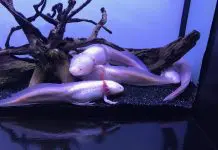

![Sick Axolotl, Fungus, Stress Symptoms [Axolotl Illness Guide 2025] Axolotl fungus](https://exopetguides.com/wp-content/uploads/2018/06/axolotl-218x150.jpg.webp)
